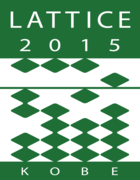Speaker
Mr
Daniel Schmidt
(Theoretisch-Physikalisches Institut, Jena University)
Description
The Thirring model is a four fermion theory with vector interaction. We study it in three dimensions, where it is closely related to QED and other models used to describe properties of graphene. In addition it is a good toy model to study chiral symmetry breaking, since a phase with broken chiral symmetry is present for the model with one fermion flavour. On the other hand, there is no such phase in the limit of infinitely many fermion flavours. Thus, a transition at some critical flavour number Nfc is expected, where the broken phase vanishes.
The model was already studied with different methods, including Schwinger-Dyson, functional renormalization group and lattice approaches. Most studies agree that there is indeed a phase transition from a chirally symmetric phase to a spontaneously broken phase for a small number of fermion flavours. But there is no agreement on the critical flavour number and further details of the critical behaviour. Values of Nfc found in the literature usually range between 2 and 7.
All earlier lattice studies were performed with staggered fermions, where it is questionable if the lattice model has the same chiral symmetry as the continuum version. We present new results from simulations of the Thirring model with SLAC fermions. With this choice, we can be sure to implement the same chiral symmetry of the continuum model. First estimates for the critical flavour number are given in this talk.
Primary author
Mr
Daniel Schmidt
(Theoretisch-Physikalisches Institut, Jena University)
Co-authors
Prof.
Andreas Wipf
(Theoretisch-Physikalisches Institut, Jena University)
Dr
Björn Wellegehausen
(Theoretisch-Physikalisches Institut, Jena University)

